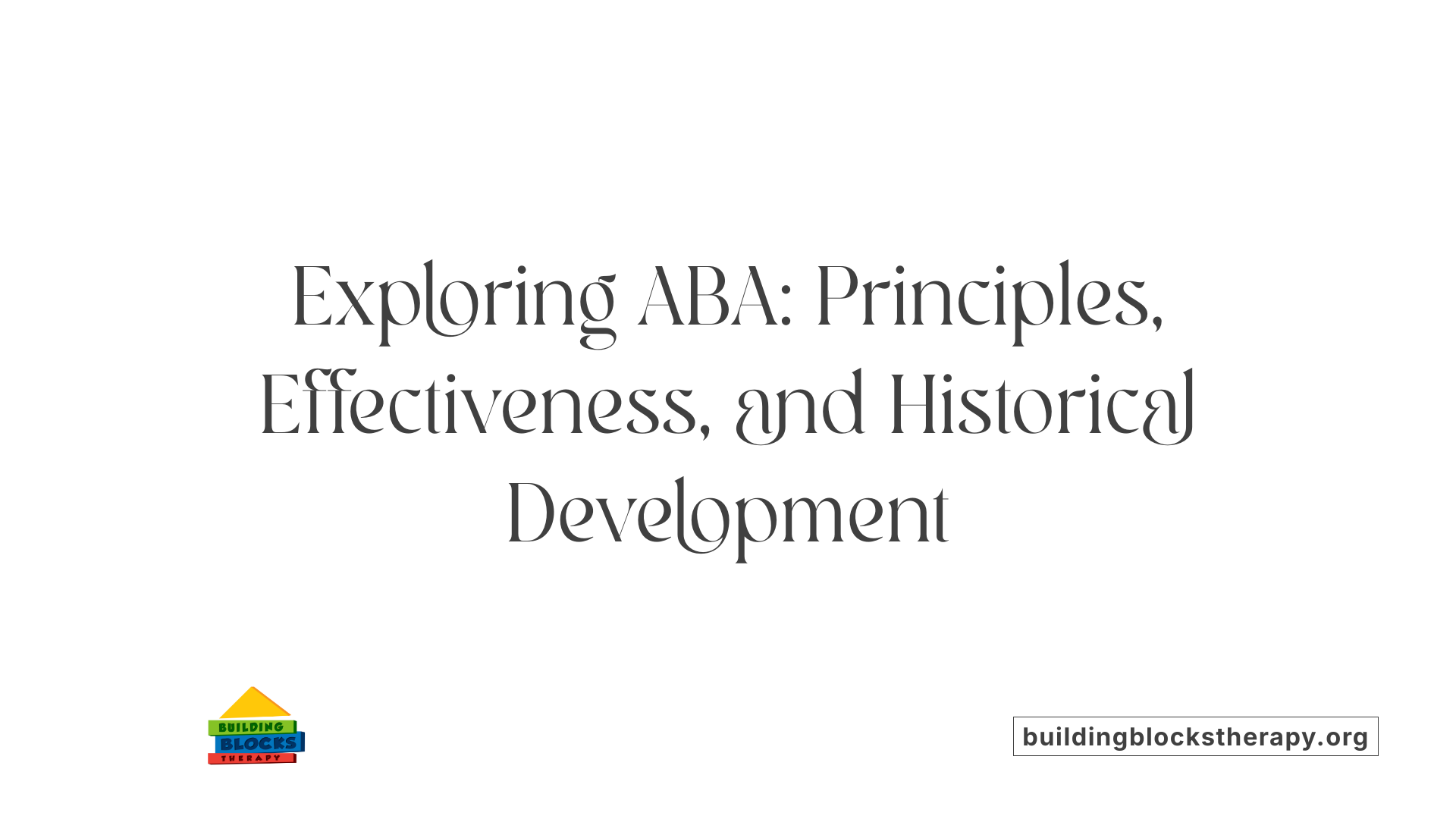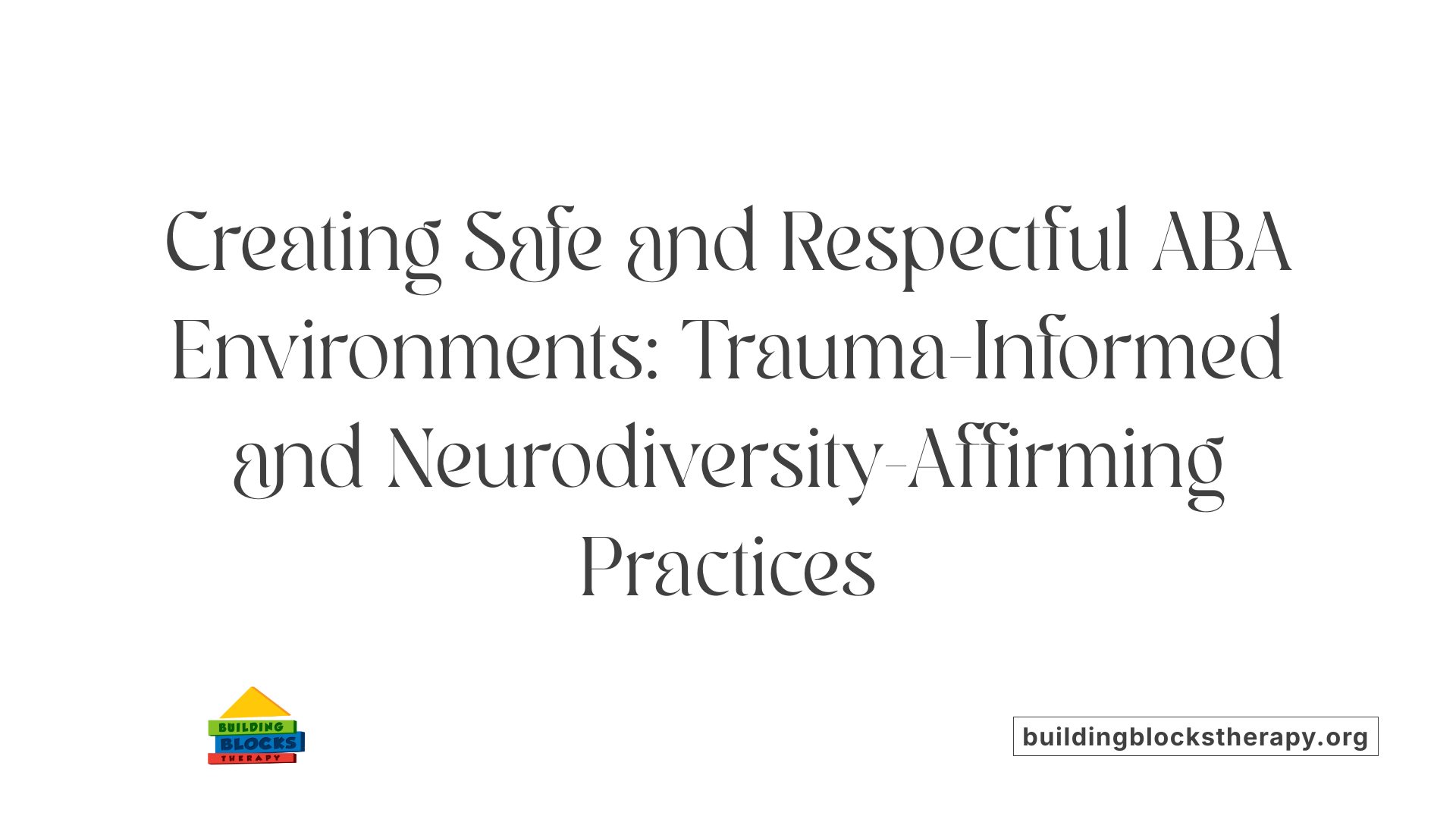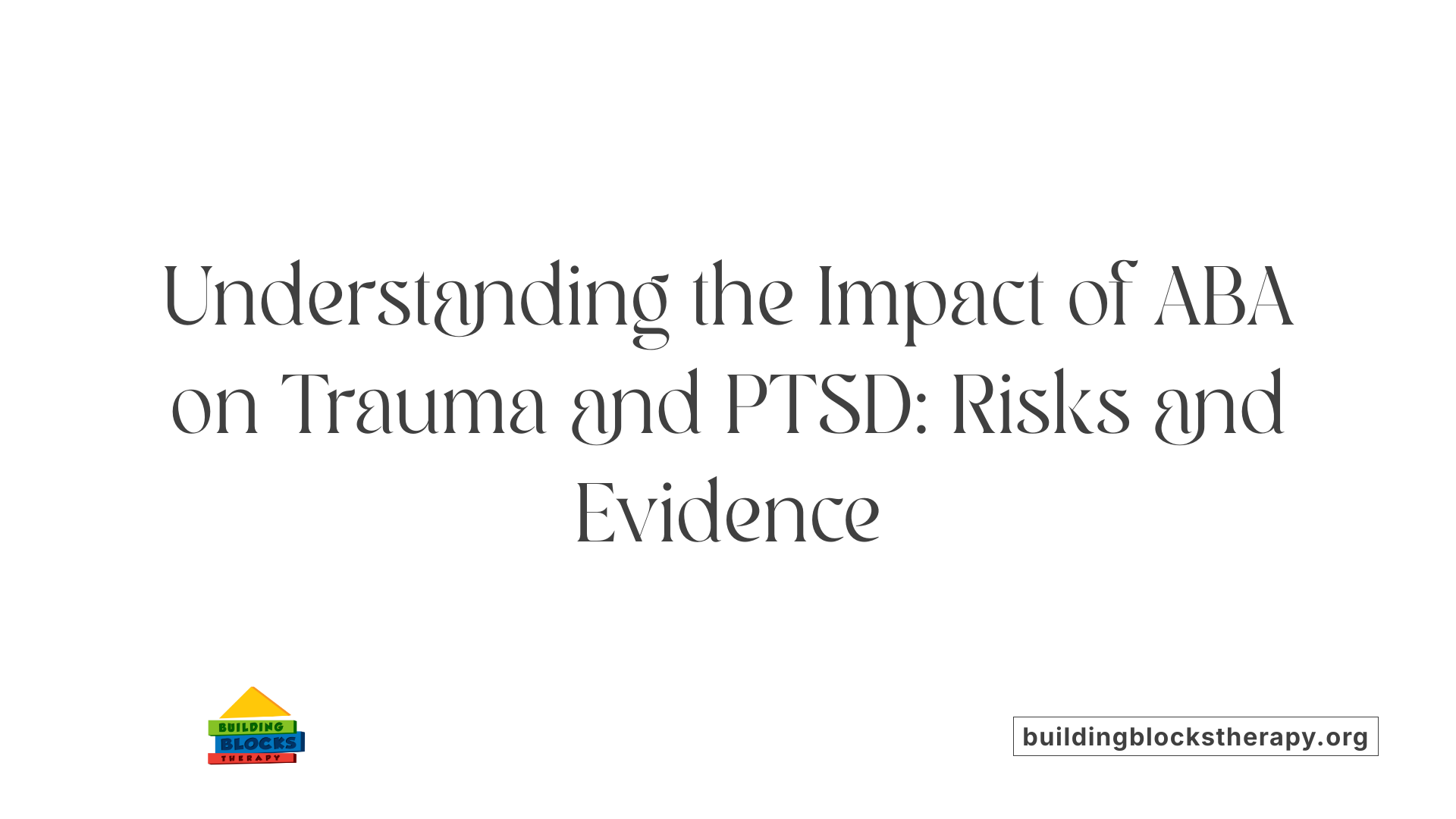Understanding the Intersection of ABA, Autism, and Trauma
Applied Behavior Analysis (ABA) is widely recognized for its effectiveness in supporting individuals on the autism spectrum. Originally developed in the 1960s, ABA employs scientifically grounded techniques based on operant conditioning to improve social skills, communication, and other behaviors. However, its application in cases involving trauma and PTSD has become a topic of critical discussion, emphasizing the need for trauma-informed and neurodiversity-affirming practices. This article delves into the nuanced relationship between ABA therapy and trauma management, examining current research, ethical considerations, and how the approach can be adapted to support well-being while minimizing harm.
The Foundation and Evolution of ABA in Autism Support

What is ABA and its principles?
Applied Behavior Analysis (ABA) is a behavior-based intervention rooted in scientific principles, especially operant conditioning as described by B.F. Skinner. It focuses on modifying behaviors through techniques like positive reinforcement, behavior shaping, and systematic data collection. ABA is designed to understand how environmental contingencies influence behavior and uses this understanding to help individuals learn new skills and reduce maladaptive behaviors.
The approach involves detailed analysis of behaviors, identification of environmental factors, and the implementation of targeted interventions. Early pioneers like Ivar Lovaas in the 1960s popularized ABA as a method to support children on the autism spectrum, primarily in naturalistic settings such as homes and community environments.
How effective is ABA in promoting skills?
Research widely supports ABA’s effectiveness for individuals with autism, showing significant improvements in social communication, adaptive skills, and overall functioning. ABA techniques help teach children and adults new skills, promote independence, and decrease problematic behaviors.
In addition to skill development, ABA is used to foster emotional regulation and social interaction, which are vital for community integration. Its systematic approach ensures progress is measurable, with continuous data collection guiding the treatment process.
Historical development of ABA
Originally developed in the 1960s, ABA was inspired by Skinner's operant conditioning theory. Ivar Lovaas, one of its most influential figures, applied ABA principles to help children with autism improve in various developmental areas. Over time, ABA expanded beyond early behavioral interventions and became integrated into a broad range of settings, from clinics and schools to home environments.
Core principles and techniques
ABA's core involves analyzing behavior functions, reinforcing desirable actions, and modifying antecedents and consequences to shape behavior. Common techniques include positive reinforcement, prompting, fading, and naturalistic teaching.
Data-driven decision-making is central—behaviors are monitored meticulously to assess progress and refine interventions.
Efficacy in social communication and skill building
Today, ABA remains a cornerstone in support strategies for autism, helping individuals develop foundational skills such as communication, self-care, and social interaction. Its adaptability allows for person-centered approaches that respect individual needs and preferences, making it effective and personalized.
| Aspect | Description | Example |
|---|---|---|
| Core Principle | Environmental influence on behavior | Reinforcing communication attempts |
| Techniques | Methods to encourage desired changes | Positive reinforcement, modeling |
| Settings | Where ABA is used | Homes, schools, clinics |
| Goals | Outcomes of therapy | Improved social skills, independence |
This comprehensive foundation of ABA underscores its role as an evidence-based therapy, evolving to meet the diverse needs of individuals with autism.
Trauma-Informed and Neurodiversity-Affirming Approaches in ABA
 Adapting ABA to be trauma-informed is essential for supporting individuals with PTSD and other trauma-related conditions. This involves thoroughly assessing each person's trauma history to tailor interventions that prioritize safety, trust, and collaboration. Creating a predictable and empathetic environment helps reduce anxiety and emotional distress. For example, practitioners should use trauma-sensitive language and offer choices whenever possible, empowering individuals to feel in control of their interventions.
Adapting ABA to be trauma-informed is essential for supporting individuals with PTSD and other trauma-related conditions. This involves thoroughly assessing each person's trauma history to tailor interventions that prioritize safety, trust, and collaboration. Creating a predictable and empathetic environment helps reduce anxiety and emotional distress. For example, practitioners should use trauma-sensitive language and offer choices whenever possible, empowering individuals to feel in control of their interventions.
Creating supportive environments also involves respecting sensory sensitivities. Many individuals with PTSD or neurodivergence have heightened sensory needs; thus, it’s important to minimize overwhelming stimuli and adapt settings to comfort each person. Environmental adjustments, such as quiet spaces or sensory tools, can help maintain emotional stability and promote engagement.
Respecting individual autonomy is a cornerstone of ethical ABA. Techniques should focus on naturalistic interventions that encourage voluntary participation and leverage a person’s interests. This approach not only minimizes potential harm but also fosters resilience and positive growth.
What are best practices to ensure ethical and respectful ABA?
To deliver ethical and respectful ABA, practitioners need specialized training in trauma-informed care principles. This includes self-awareness and reflexivity to recognize personal biases and ensure interventions do not inadvertently cause harm. Incorporating genuine consent through transparent communication is vital, as is respecting each individual's pace and comfort levels.
Implementing naturalistic approaches and positive reinforcement can help highlight strengths and encourage progress while reducing reliance on punitive or overly controlling methods. Regular evaluation and client feedback are crucial to adapt interventions that genuinely meet individual needs and uphold dignity.
In summary, trauma-informed and neurodiversity-affirming ABA focuses on creating safe, respectful, and empowering settings. It integrates scientific practices with compassionate care, ensuring that interventions support both behavioral development and emotional well-being.
ABA, Trauma, and PTSD: Risks, Effects, and Evidence

What are the potential risks of ABA for autistic individuals with trauma?
Traditional ABA practices have historically emphasized compliance and behavior suppression, which can sometimes impede emotional safety and potentially worsen trauma symptoms. Techniques perceived as punitive or overly controlling might cause retraumatization, especially if they overlook the individual's emotional state or fail to respect personal boundaries.
While ABA can be highly effective for skill development, when delivered without a person-centered approach, it may inadvertently increase stress and anxiety. Recent shifts in practice advocate for respectful, trauma-informed ABA that emphasizes positive reinforcement, naturalistic interactions, and environmental adjustments. This approach aims to support healing and resilience, minimizing the risk of trauma exacerbation.
What does current research indicate about ABA's impact on trauma symptoms?
Emerging research raises concerns about the relationship between ABA and trauma symptoms. Studies show that exposure to certain ABA practices may correlate with increased PTSD severity and higher likelihood of trauma-related stress responses.
Specifically, individuals subjected to outdated or coercive ABA methods have been observed to exhibit higher rates of PTSD symptoms. Conversely, modern, ethically responsive ABA emphasizes trauma-sensitive techniques, emphasizing autonomy, choice, and respectful engagement.
Collectively, the evidence highlights the importance of carefully tailoring ABA interventions to avoid adverse effects while supporting positive behavioral and emotional outcomes. Ongoing research continues to investigate the best practices for integrating trauma-informed care within ABA frameworks.
| Aspect | Description | Additional Notes |
|---|---|---|
| Potential Risks | Exacerbation of trauma symptoms, retraumatization | Emphasizes compliance over emotional safety |
| Recent Findings | Increased PTSD severity linked to traditional ABA | Advocates for trauma-sensitive methods |
| Modern Approach | Focus on positive reinforcement and respect | Aims to minimize adverse effects |
Understanding the impact of ABA on trauma remains crucial in applying these interventions ethically and effectively. Ensuring that ABA practices support healing rather than harm is fundamental to ethical treatment and long-term well-being.
The Role of ABA in Managing PTSD Symptoms
 Applied behavior analysis (ABA) is a behavior-based approach grounded in scientific principles that is increasingly being explored for managing symptoms of PTSD, especially in autistic individuals. It uses techniques like functional analysis, positive reinforcement, and active engagement strategies such as behavioral activation to reduce avoidance behaviors and promote healthier coping with trauma-related emotions.
Applied behavior analysis (ABA) is a behavior-based approach grounded in scientific principles that is increasingly being explored for managing symptoms of PTSD, especially in autistic individuals. It uses techniques like functional analysis, positive reinforcement, and active engagement strategies such as behavioral activation to reduce avoidance behaviors and promote healthier coping with trauma-related emotions.
Behavioral activation, a form of ABA rooted in operant conditioning, involves assessing the functions of specific behaviors and encouraging individuals to engage in meaningful activities. It aims to re-establish routines, help pursue personal goals, and strengthen social connections—all vital for recovery from trauma. The treatment typically includes steps like orientation, identifying distress, setting goals, performing behavior analyses, and relapse prevention.
Research indicates that exposure to ABA is associated with a higher likelihood of meeting PTSD diagnostic criteria. About 46% of respondents exposed to ABA met the threshold for PTSD, with nearly half experiencing extreme severity levels. Interestingly, individuals—both children and adults—exposed to ABA had increased chances (41% for adults and 130% for children) of exhibiting PTSD symptoms compared to those not receiving ABA.
While ABA remains an established method for behavior change, its application to trauma-related conditions like PTSD requires careful, trauma-informed implementation. Conventional ABA practices, if not adapted appropriately, may pose risks of inadvertently re-traumatizing individuals or increasing symptoms.
How does ABA differ from other trauma-focused treatments? Unlike trauma-focused therapies such as cognitive-behavioral therapy (CBT) or eye movement desensitization and reprocessing (EMDR), which directly target trauma memories and emotional processing, ABA emphasizes behavior modification through reinforcement. Modern trauma-informed ABA integrates sensitivity to trauma impacts, creating a safe environment that respects individual experiences.
For individuals with autism experiencing PTSD, ABA can support emotional regulation and reduce avoidance, but practitioners must prioritize safety and personal agency. That involves integrating positive, person-centered strategies, naturalistic interventions, and environmental adjustments to minimize adverse effects.
In summary, ABA offers a versatile framework that, when applied with trauma sensitivity, can contribute to managing PTSD symptoms and improving overall resilience for autistic and neurodiverse populations.
Safety, Controversies, and Future Directions in ABA
What safety considerations are crucial when applying ABA with trauma-experienced individuals?
Implementing trauma-informed practices in ABA involves essential safety considerations to prevent re-traumatization. Practitioners should ensure informed consent, clearly explaining procedures and goals to clients and their families. Responding sensitively to emotional distress during sessions helps maintain a sense of safety. Additionally, avoiding coercive, aversive, or punishment-based techniques is critical, favoring naturalistic and flexible approaches that respect individual boundaries. This focus on emotional safety promotes trust and supports healing.
What are the main controversies surrounding ABA in the context of trauma?
Despite its scientific basis and proven effectiveness, ABA remains controversial for some. Critics express concerns that traditional ABA methods, especially those involving punishment or masking behaviors, may cause trauma or emotional exhaustion. These practices can sometimes suppress natural behaviors and lead to feelings of loss of autonomy.
There is ongoing debate about how ABA impacts neurodiversity and individual identity. While many advocate for ethical, person-centered ABA that emphasizes positive reinforcement and collaborative care, some argue that historically rigid approaches can undermine personal agency. The controversy underscores the importance of ongoing research and continuous refinement of ABA techniques.
Evolving practices and research needs
The future of ABA in trauma and autism care is trending toward trauma-sensitive and neurodiversity-affirming models. Emphasizing ethical practices, such as respecting individual autonomy and involving stakeholders in treatment planning, is crucial. Incorporating trauma-informed care approaches can help tailor interventions to minimize harm.
Research efforts are essential to validate these emerging models and explore their long-term effects. Ongoing evaluation, stakeholder involvement, and adaptation to individual needs will help ensure ABA remains a safe, effective, and respectful intervention.
| Aspect | Focus | Description |
|---|---|---|
| Safety considerations | Trauma-informed practices | Respecting emotional well-being, avoiding coercion |
| Controversies | Ethical debates | Impact on neurodiversity, trauma concerns |
| Future directions | Ethical, personalized care | Trauma-sensitive, stakeholder-involved, research-driven approaches |
Advances in understanding trauma, neurodiversity, and ethical practices continue to shape the evolution of ABA, aiming for interventions that are both effective and respectful.
Balancing Innovation and Responsibility in ABA
As ABA continues to evolve, integrating trauma-informed, neurodiversity-affirming practices is essential to support autistic individuals holistically. Ethical implementation, ongoing research, and genuine collaboration with individuals and families will help maximize benefits while minimizing potential harms. By respecting individual experiences and promoting resilience, ABA can play a meaningful role in fostering well-being for autistic people with trauma histories.
References
- Applied Behavior Analysis in PTSD Therapy
- Evidence of increased PTSD symptoms in autistics exposed to ...
- Does Applied Behavior Analysis (ABA) Cause Trauma?
- How ABA Therapy Helps Manage PTSD Symptoms
- Does Applied Behavior Analysis (ABA) Cause Trauma?
- Applied Behavior Analysis in PTSD Therapy
- Evidence of increased PTSD symptoms in autistics exposed to ...






